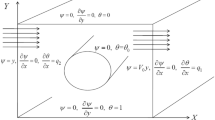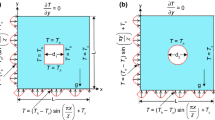Abstract
A numerical study has been made of the heat transfer through a fluid layer with recirculating flow. The outer fluid surface was assumed to be spherical, while the inner surface consisted of a sphere concentrically or eccentrically located with respect to the outer spherical surface. The recirculating flow was assumed to be driven by a gas flow creating stress on the fluid's outer surface so that creeping (low Reynolds number) flow developed in its interior. The present study solves the Stokes equation of motion and the convective diffusion equation in bispherical coordinates and presents the streamline and isotherm patterns.
Similar content being viewed by others
Abbreviations
- a i :
-
inner sphere radius
- a d :
-
outer sphere radius
- A 1 :
-
defined by equation (5)
- A 2 :
-
defined by equation (6)
- B 1 :
-
defined by equation (7)
- B 2 :
-
defined by equation (8)
- c :
-
dimensional factor for bispherical coordinates
- C :
-
constant in equation (4)
- d′ :
-
narrowest distance between the two eccentric spheres
- E 2 :
-
operator defined by equation (1) in spherical coordinates and by equation (21) in bispherical coordinates
- G :
-
modified vorticity, defined in equation (22)
- G * :
-
non-dimensional modified vorticity, defined in equation (28)
- h ϕ :
-
metric coefficient of bispherical coordinate system, defined in equation (18)
- k w :
-
thermal conductivity of water
- K 1 :
-
defined by equation (9)
- K 2 :
-
defined by equation (10)
- N Re :
-
Reynolds number=2a dU∞/gn
- N Pe,h :
-
Peclet number=2a dU∞/κ
- n :
-
integer counter
- q :
-
heat flux
- r :
-
radius
- r * :
-
non-dimensional radius=r/a d
- S :
-
surface area
- t :
-
time
- t * :
-
non-dimensional time=κt/a 2d
- T :
-
temperature
- T o :
-
temperature at inner sphere surface
- T a :
-
temperature at outer sphere surface
- T * :
-
non-dimensional temperature;=(T−T o)/(Ta−To)
- u :
-
velocity
- u r :
-
radial velocity in spherical coordinates
- u θ :
-
angular velocity in spherical coordinates
- u η :
-
radial velocity in bispherical coordinates
- u ξ :
-
angular velocity in bispherical coordinates
- U ∞ :
-
free stream velocity
- u r * :
-
=u r/U∞
- u θ * :
-
=u θ/U∞
- u η * :
-
=u η/U∞
- u ξ * :
-
=u ξ/U∞
- δa 1 :
-
small displacement
- ζ:
-
vorticity, defined in equation (17)
- ζ* :
-
non-dimensional vorticity, defined in equation (27)
- η:
-
radial bispherical coordinates
- ηo :
-
bispherical coordinate of inner sphere
- ηa :
-
bispherical coordinate of outer sphere
- θ:
-
angular coordinate in spherical coordinates
- κ:
-
thermal diffusivity
- κw :
-
thermal diffusivity of water
- ν:
-
kinematic viscosity
- ξ:
-
angular bispherical coordinate
- ϕ:
-
spherical coordinate
- ψ:
-
streamfunction
- ψ′ :
-
non-dimensional streamfunction for spherical coordinates, = ψ/(U ∞a 2d )
- ψ* :
-
non-dimensional streamfunction for bispherical coordinates, defined in equation (26)
References
Astill, K. N. (1976),An analysis of laminar forced convection between concentric spheres, ASME J. Heat Transfer,98, 601–608.
Carslaw, H. S., andJaeger, J. C.,Conduction of Heat in Solids, (Second Edition, Clarendon Press, Oxford 1959) 510 p.
Douglass, R. W., Shaughnessy, E. J., andMunson, B. R. (1979)Small Reynolds number convection in rotating spherical annuli, ASME J. Heat Transfer101, 427–433.
Happel, J., andBrenner, H.,Low Reynolds Number Hydrodynamics (Prentice-Hall, Inc., Englewood Cliffs, New Jersey 1965) 553 p.
Kronig, R., andBrink, J. C.,On the theory of extraction from falling droplets, Appl. Sci. ResearchA2, 142–154.
Le Clair, B. P., Hamielec, A. E., Pruppacher, H. R., andHall, W. D. (1972),A theoretical and experimental study of the internal circulation in water drops falling at terminal velocity in air, J. Atmos. Sci.29, 728–740.
Maolem, D. M., andMiloh, T. (1976),Theoretical analysis of heat and mass transfer through eccentric spherical fluid shells at large Peclet number, Appl. Sci. Research32, 395–414.
Rasmussen, R. M. (1982),The Melting of Spherical Ice Particles Falling at Terminal Velocity in Air: An Experimental and Theoretical Study (Ph.D. Thesis, Public. No. 83/06, 106, University Microfilms, Ann Arbor, Michigan) 385 p.
Rasmussen, R. M., andPruppacher, H. R. (1982),A wind tunnel and theoretical study of the melting behaviour of atmospheric ice particles: I. A. wind tunnel study of frozen drops of radius<500 μm, J. Atmos. Sci.39, 152–158.
Rundell, H. A., Ward, E. G., andCox, J. E. (1968),Forced convention in concentric-sphere heat exchanges, ASME J. Heat Transfer90, 125–129.
Weber, N., Powe, R. E., andBishop, E. H. (1973),Heat transfer by natural convection between vertically eccentric spheres, ASME J. Heat Transfer95, 47–52.
Woo, S., andHamielec, A. E. (1971),A numerical method of determining the rate of evaporation of small drops falling at terminal velocity in air, J. Atmos. Sci.28, 1448–1454.
Yao, L. S. (1980),Analysis of heat transfer in slightly eccentric annuli, ASME J. Heat Transfer102, 279–284.
Author information
Authors and Affiliations
Rights and permissions
About this article
Cite this article
Rasmussen, R.M., Levizzani, V. & Pruppacher, H.R. A numerical study of the heat transfer through a fluid layer with recirculating flow between concentric and eccentric spheres. PAGEOPH 120, 702–720 (1982). https://doi.org/10.1007/BF00876656
Issue Date:
DOI: https://doi.org/10.1007/BF00876656




